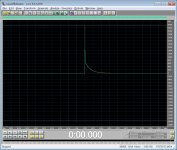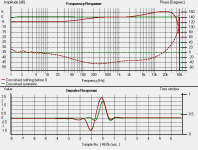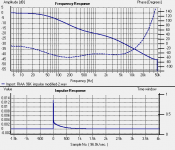In the meantime you can check out digital RIAA with an 8000 tap FIR or an IIR plugin with the files and links I posted in this thread. They really do work, promise. 😉
All you need is a player like JRiver media center, Foobar or similar. Fairly easy to do.
All you need is a player like JRiver media center, Foobar or similar. Fairly easy to do.
In the meantime you can check out digital RIAA with an 8000 tap FIR or an IIR plugin with the files and links I posted in this thread. They really do work, promise. 😉
All you need is a player like JRiver media center, Foobar or similar. Fairly easy to do.
Sure, I just downloaded Foobar and foo-convolve. Looks like all these solutions will work.
EDIT - you mean from post #75? Those are linear phase and non causal, you want the causal "nothing before 0" version see attached or the phase will not be correct (like an R/C version). I don't think the "inaudibility of phase" goes that far.
Attachments
Last edited:
So this looks like a non-problem. There are any number of free software packages that allow you create amplitude/phase spectra simply from the circuit poles and zeros and a little complex algebra. Then you generate the impulse response with something like an inverse Hilbert transform to generate a minimum phase one. The entire gamut of historical curves could easily be generated.
It seems the hardware has caught up in speed to where 1000's of floating point multiply/adds can be done in line. BTW pano someone has made a Foobar plug-in for BruteFIR but it looked like a software geek only job to replicate. If you read the BruteFIR benchmarks they are hard to believe.
It seems the hardware has caught up in speed to where 1000's of floating point multiply/adds can be done in line. BTW pano someone has made a Foobar plug-in for BruteFIR but it looked like a software geek only job to replicate. If you read the BruteFIR benchmarks they are hard to believe.
Last edited:
EDIT - you mean from post #75? Those are linear phase and non causal, you want the causal "nothing before 0" version see attached or the phase will not be correct (like an R/C version)
Thanks Scott! I will edit my files to causal. In tests I didn't see the phase problems, just some small amplitude errors. Perhaps this will fix it.
Thanks Scott! I will edit my files to causal. In tests I didn't see the phase problems, just some small amplitude errors. Perhaps this will fix it.
Cooledit (and some other programs) only show the magnitude of the FFT, your impulses looked pretty good on magnitude. Flattening the phase will cause time domain errors compared to a real RIAA. I'm working on a Python worksheet to do the calculations.
Just to confirm, would you do RIAA before anything else? For example correcting cartridge FR if you can't get it as flat as you would like with loading alone?
People don't (want to) realize how many things they can achieve by embracing the "dark" (digital) side for their analogue front-end.
What many things are you referring to other than recording?
What many things are you referring to other than recording?
Well, it sure opens up a lot of possibilities for messing around with crossovers, time alignment...
Well, it sure opens up a lot of possibilities for messing around with crossovers, time alignment...
You mean for distributing signal to a bi-amped system with a subwoofer or something like that?
Good question, and important. It's going to come down to gain structure. I think I would try to fix the cartridge first, then do RIAA, then a final gain for both channels.Just to confirm, would you do RIAA before anything else? For example correcting cartridge FR if you can't get it as flat as you would like with loading alone?
If you are using JRiver to do this, you can write the output to a wave file and have a close look. Easy to turn on and off or reorder different parts of the DSP and check. The Analyzer in the DSP section will also tell you RMS signal values and peak is there too. Those should be watched to get the best results.
Well, it sure opens up a lot of possibilities for messing around with crossovers, time alignment...
That's one big can of worms.
Another can includes denoising, declicking, removing surface noise, applying your own edits/EQs, and archiving the end result (on digital and/or analogue media). There are numerous plugins and software suites, both from hardware vendors and independent development houses, for stuff like that.
You mean for distributing signal to a bi-amped system with a subwoofer or something like that?
Yes. IME good things happen when each driver has its own amp.
Just to confirm, would you do RIAA before anything else? For example correcting cartridge FR if you can't get it as flat as you would like with loading alone?
Could you lump the correction into the RIAA filter and do it all at once? I.e. tweak the RIAA curve to match that particular cartridge.
Maybe, but that's possibly not optimal. I've got to relearn all my DSP stuff after decade of non-use.
The other thing I am considering is splitting into sum and difference for low frequency processing (where vinyl is mono). That has to go after RIAA unless I am missing something that those versed in the ART know.
The other thing I am considering is splitting into sum and difference for low frequency processing (where vinyl is mono). That has to go after RIAA unless I am missing something that those versed in the ART know.
A full range summing option would be good for mono recordings where the vertical output from the cartridge is unwanted.
Has anyone got any opinions on what is required for the analogue front end.
1: Cartridge loading
2: Initial gain stage - Simple first order hi pass warp / rumble filter? Balanced or unbalanced input / output?
3: A to D stand alone, or input to separate A to D such as PC sound card?
Thinking of building a front end prototype.
Has anyone got any opinions on what is required for the analogue front end.
1: Cartridge loading
2: Initial gain stage - Simple first order hi pass warp / rumble filter? Balanced or unbalanced input / output?
3: A to D stand alone, or input to separate A to D such as PC sound card?
Thinking of building a front end prototype.
I was thinking MiniDSP AN-FP -> miniSHARC. From there I'd go I2S to a miniDSP 2x8 (actually 4x10HD) that I use for my crossover. Haven't thought about cartridge loading yet, but intended to try and skip the initial gain stage and use MM to start.
A full range summing option would be good for mono recordings where the vertical output from the cartridge is unwanted.
Has anyone got any opinions on what is required for the analogue front end.
1: Cartridge loading
2: Initial gain stage - Simple first order hi pass warp / rumble filter? Balanced or unbalanced input / output?
3: A to D stand alone, or input to separate A to D such as PC sound card?
Thinking of building a front end prototype.
Well it's not necessarily sane, but I need an excuse to buy one of SYs EO phono stages. As that is balanced in and out as well as low input capacitance and very low noise it seems to tick a lot of boxes. Oh and it has tubes which is always good 🙂
You could. The tools are pretty easy. Or just EQ the cart first, then keep to a standard RIAA. Do you have a test LP to measure with?Could you lump the correction into the RIAA filter and do it all at once?
I don't understand why you would do that. Vinyl is somewhat mono at the low end, but not entirely. Any decent processor will have no trouble handling 2 streams. Isn't there enough cross talk already?The other thing I am considering is splitting into sum and difference for low frequency processing (where vinyl is mono).
I can see the advantage in mono, I've done that post recording. Keep only the signal common to Left and Right. It works to reduce noise.
- Home
- Source & Line
- Digital Line Level
- What about digital RIAA?

 Very interested to see how you generate the impulse.
Very interested to see how you generate the impulse. 
